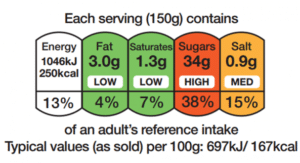
Food & Drink Labels
Food and drink labels – what are they, what purpose do they serve and how should you use them?
Reverse Packaging Labels
Food labels state what the food or drink contains. There are laws outlined on what food and drink labels need to include, and how this needs to be presented.
Using the information on these labels can help you to make healthier and more balanced nutrition choices. This can include choosing items that are lower in:
- Fat
- Saturated fat
- Salt
- Sugar
- Calories
By law, the nutrition label on the back of packaging needs to include:
- Energy (calories): Knowing the calorie content can help you monitor your calorie intake.
- Fat: This includes saturated and unsaturated fats.
- Saturated fat: You should try to keep saturated fat intake to a minimum as it can increase your cholesterol level, therefore increasing your risk of heart disease and stroke.
- Carbohydrate: This includes both starch that you find within food products, and sugars. This includes the sugar you personally add to drinks such as tea and coffee, sugars that have been added to food and drink by manufacturers, and sugars that are naturally occurring in honey, syrup, fruit juices, fruit and milk.
- Sugar: This refers to how much of the carbohydrate in your food comes from sugars (the remainder being from starch). Note that ‘total sugars’ are declared on food labels but dietary recommendations are based on ‘free sugars’.
– Free sugars: Those added by food and drink manufacturers and those naturally present
in honey, syrups and unsweetened fruit juices.
– Total sugars: Those naturally present in whole fruit and milk, and all free sugars.
- Protein: Your body needs protein to grow and repair.
- Salt: The salt within your food can be added directly into it, be naturally occurring or be in the form of raising agents and additives.
These nutritional properties must only be displayed as per 100g or 100ml of the product. Some products also display the nutritional quantities per portion, but this isn’t consistent. It is therefore worth checking the nutritional breakdown for the quantity you will be consuming to understand your personal nutritional intake.
Front Packaging Labels
Repeating the nutritional information on the front of a product is optional in the UK. However, companies recognise that this information is incredibly useful to the consumer. The information enables you to glance at the product and establish the nutritional content of the item and whether this is something you wish to have.
Breakdown of nutritional content:
- Energy (calories) only
OR
- Energy (calories)
- Fat
- Saturated fat
- Sugars (total sugars)
- Salt
Once again, this information will be written per 100g/100ml, per portion, or both – be sure to know what the nutritional intake is per amount you consume. The recommended format is the traffic light system – making it easy to understand at a glance using green, amber and red colour coding. This system is really useful when you want to compare several food choices with one another. Below is an example:

You will see that the above illustration also gives the percentage contribution of the reference intake.
What is a reference intake and why is this important?
Reference intake is based on an average sized woman doing an average amount of physical activity. It is not a target for you to consume, but should be seen as a guideline or benchmark when make nutritious conscious choices in order to consume a balanced diet. It essentially enables you to put the numbers into context.
Health Claims
Food packaging containing health claims will be authorised due to meeting certain criteria.
There are stringent rules and criteria to meet based on science for companies to make health claims about their products. This is to ensure there is clear understanding for the buyer, and that they are not being misled.
This also encourages manufacturers to produce healthier products in order to be able to have products that can qualify in making health claims that will appeal to the public.
Health claim examples include:
- Sugar free: must contain less than 0.5g sugars per 100g
- Low fat: must contain less than 3g fat per 100g
- High in fibre: must contain at least 6g fibre per 100g
- Source of vitamin D: must contain at least 15% of the recommended intake for vitamin D per 100g
Other Information
- Ingredients
- Allergens
- Additives
Key Information
- The information found on nutrition labels are a useful tool when eating a healthy and balanced diet
- You are able to make quick and easy comparisons between products at a glance of the calorie content, fat, saturated fat, salt and sugars
- Be clear on the nutritional breakdown per quantity of food as this can be per 100g/100ml or per portion
Part 1: Simple, healthy and easy – top tips for a balanced diet


